For well over five years now, vom Boden has been offering an unparalleled deep-dive into one of the most magical and curious facets of German wine culture: the German wine auctions.
This year, to be honest, we’ve gone a bit nuts.
This 7,500+ word diatribe covers our favorite (roughly 60!) lots from the three important auctions taking place Friday through Sunday, September 15th-17th. If anyone actually reads this entire report, email me and I’ll send you an official vom-Boden branded “thank you for being a passionate, crazy person” letter, hand-signed by me.
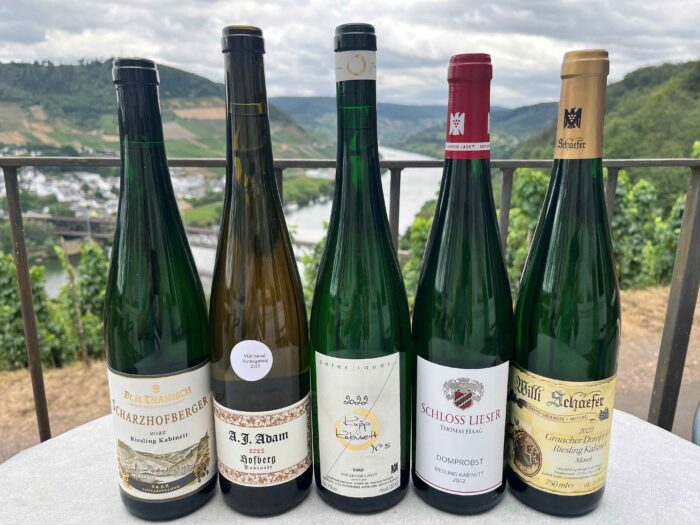
While the easy selling line for the auction is something like, “This is your chance to buy the greatest and rarest wines of Germany!” – and that line is 100% true – I think it undermines, or at least takes a detour around, the beautiful human tradition of the event. It pushes to the side what’s really important about all this, like selling the Statue of Liberty based on the incredible views of New York City it affords.
The greater, more important truth of these auctions is the acknowledgment of just how complicated terroir is, just how little we really understand and can explain. Some barrels, some vineyards, some parcels are just better than others. These auctions celebrate this. For more on the magic and the history of these auctions, click here.
If you would like to bid, vom Boden will once again be providing complete consulting, bidding and logistics services for clients in the U.S.
PLEASE REACH OUT ASAP FOR A BIDDING SHEET. ALL BIDS MUST BE PLACED BY WEDNESDAY, SEPTEMBER 13TH. Email orders@vomboden.com
If you are interested in bidding, we should state this clearly: While there are always some incredibly high prices paid, there are a lot of affordable wines sold at the auction as well. This isn’t going to be bargain shopping; but you don’t have to wear an ascot to bid either.
We can help you find the deals and give you tips on the growers and the wines – please see below. We’ve spent about a month in Germany this summer actually visiting the growers, tasting tons of auction bottlings from all the big names (Egon Müller, Keller, Lauer, Willi Schaefer, J.J. Prüm, Emrich-Schönleber, Schäfer-Fröhlich, etc.) but it is also a significant point of pride that we seek out the surprises and sleeper-hits as well – the values.
In short: In the U.S. at least, I don’t think there is anyone else in this as deeply as we are.
thoughts on the 2023 auctions
To some extent, the strength of the auction is based on the strength of the preceding vintage. While growers may offer wines from any back vintage (Emrich-Schönleber, for example, is offering a 2004 Eiswein), normally the major thrust of the event is the preceding vintage. So for the 2023 auctions, the events will be focusing on the 2022 vintage in Germany.
And vintage 2022 is a joy – almost literally. As I wrote in my vintage report (which you can read by clicking here): “Vintage 2022 feels to me like joy, in liquid form. The best wines of 2022 almost force you to smile, as quickly and as surely as your leg twitched when the doctor gently tapped you on your knee as a child. ‘Lightness’ is, without question, the absolute defining characteristic of the vintage… Wine dorks of all shapes and sizes bemoan the increasing alcohols of most regions, the ponderous wines that bend under their own weight. We say we value finesse and soil-transparency. And here, with 2022, we have it all – pure energy, delicacy, lightness.”
Make no mistake, many of the wines of 2022 are light and charming, but not particularly age-worthy or serious. But – and this is a big but, pun intended – there are some that are very serious. I painfully outline this in my ridiculous essay “already reconsidering the vintage,” which you can read by clicking here. After spending roughly a month in Germany this summer, tasting and drinking the wines again (and again) I have come to have considerable respect for this vintage.
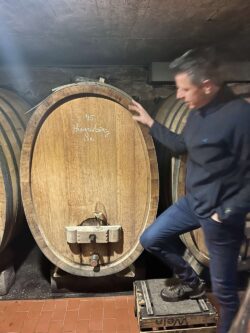 The truth is that if 2021 is the monument for the ages (and I still believe this to be the case), the top 2022ers are finer and lighter. This is no small point for the serious German wine dork. Perhaps the 2022ers will not go the distance of the 2021ers, but the top wines of 2022 will perhaps drink *better* over the next decade (or more), so if you are into drinking wines and not just collecting trophies, this is a vintage for you.
The truth is that if 2021 is the monument for the ages (and I still believe this to be the case), the top 2022ers are finer and lighter. This is no small point for the serious German wine dork. Perhaps the 2022ers will not go the distance of the 2021ers, but the top wines of 2022 will perhaps drink *better* over the next decade (or more), so if you are into drinking wines and not just collecting trophies, this is a vintage for you.
AND: I have no crystal ball – so who the hell knows – but… my guess is that buying will be a bit softer this year for many of the wines not in the white-hot spotlight. In other words, there may be some real deals to be had, especially when compared to last year’s auction.
We’ve gone digging, deep, this year – the list below is an expression of the most auction wines we’ve ever tasted, including many bottles from, for the first-time ever, the Bernkasteler Ring, as well as the VDP auctions of the Mosel and Nahe/Rheinhessen.
Please note you may bid on any wine you’d like; we have skipped numerous wines either because we didn’t taste them or they just didn’t excite us. However, this is all wildly subjective, so we are happy to bid on your behalf for anything you might be interested in.
For easy-reading we’ve given our favorite lots a red, underlined font – just to make it a bit easier to scroll through.
Finally, unless otherwise mentioned specifically in the lot title, all wines are 2022 Rieslings.
With that as a long introduction, here are some wines that seemed worthy of a bit more discussion.
vom Boden’s top picks!
To begin, je dèteste these sorts of things: “best of” lists, points, scores – anything that dumbs down something so wildly complex and beautiful, well, it makes me a bit sad. So please consider this more of a list of things I’m thinking in the lead up to the auction. As in previous years, I’ll try and make some dumb predictions so you can mock me later. That’s really the only point of lists like this.
I’ll be focusing on three auctions and we will go through them, below, in the order they will take place, starting with the VDP Mosel auctions on Friday, September 15th.
Lots 5 and 6: Lauer’s Lambertskirch GG
Lauer’s Lambertskirch GG goes to auction for only the second time; largely because this is only the second dry wine he’s made from the vineyard. The Lambertskirch vineyard is a tiny, dramatically-inclined site only a stone’s throw from the Schonfels. Growing up, Florian’s father would always tell him: “The Lambertskirch is one of the best sites out there.” It changed hands a number of times and one owner, alas, grubbed up the vines and planted a small orchard there; this too went fallow. When Florian finally had the chance to buy the site around 2008, he jumped at it. That said, it took a year to clear and it had to be completely replanted. However, Lauer decided to really invest here: The Lambertskirch is planted with 100-year-old selection massale vines taken from five villages in the Mosel: Saarburg, Wiltingen, Piesport, Cochem and Winningen. This is some special genetic material – and honestly from nearly the get-go the wines from here have been electric.
I’ve tasted the wine twice and have been very impressed, though I find young Mosel and Saar GGs to be inscrutable. That said, my general sense is that 2022 is a *great* vintage for dry Rieslings and the boys from Mosel Fine Wines (which I’ll refer to as MFW going forward) gave the wine a glowing review: “The 2022er Lambertskirch GG, as it is referred to in the central part of the label, was made from fruit harvested in this south-east facing Lieu-Dit overseeing the Saar. The first nose shows still quite some reduction with intensely smoky (smoked bacon) and herbal notes, and it is only after some extensive airing that finer scents of white flowers, anise, minty herbs, white pepper, cardamom, and vineyard peach come through. The wine is delicately herbal and spicy on the comparatively smooth and finely juicy palate. The finish already shows great spiciness and above all quite some salty flavors, and the length is splendid. This superb expression of dry Riesling only needs a couple of years to fully shine.”
I loathe, loathe, loathe, LOATHE scores, finding them absurd and insulting, but this isn’t about me, is it? I know people find scores useful, so I’ll include them here. Just note that MFW is one of the few places that does not inflate scores, so anything from a 90 or above is pretty damn special. The 2022 Lambertskirch GG got 93 points from them. That’s like a 98 from any other publication.
PRICING:
Last year pricing was a bit nuts because Florian put too many mags in the auction and not enough 750mls – so the mags went for 200 Euros while the bottles went for 185 Euros. Yup. Supply and demand. This year, he’s correcting this mistake by putting in the auction 120 bottles starting at 60 Euro and 12 magnums starting at 120 Euro. So I’d expect the 750mls to settle around 120-145 Euros and the mags at 250 Euros? Something like that?
Lots 7-12: Schloss Lieser Domprobst Kabinett and Doctor Spätlese
The Lieser auction wines – again as in 2021 a Kabinett from Domprobst and a Spätlese from za Doctor – are superb. If you like the Schloss Lieser style – glossy, sleek and focused – you’ll love these. MFW gave the Kabinett 93 points and the Spätlese 95 points.
PRICING:
The 2021 Kabinett went for 60 Euros last year, the Spätlese for 225 Euros – I’d expect the prices to be about the same this year. Last year Thomas put in 480 bottles of Kabinett and this year there are 540, so maybe we’ll even see a slight price dip – could be?
Lots 13-14: Clemens Busch Marienberg Kabinett Fass 4 and Spätlese Fass 82
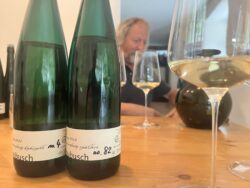 Clemens (like Lauer) sends a good amount of wine to the auction to help prices stay low. As in the past two years, Clemens will send 720 bottles of his Kabinett Fass 4 to the auction. This year there will also be 360 bottles of Spätlese Fass 82.
Clemens (like Lauer) sends a good amount of wine to the auction to help prices stay low. As in the past two years, Clemens will send 720 bottles of his Kabinett Fass 4 to the auction. This year there will also be 360 bottles of Spätlese Fass 82.
I hadn’t seen Clemens in too many years so it was a joy to sit with him on a quiet Sunday this past July; I have been tasting with Clemens since 2007 which is sort of crazy to think about. The 2022ers are both lovely bottlings in that Clemens Busch style – some texture and heft, but also a lightness, a clarity. MFW gave the Kabinett 93 points and the Spätlese 94+.
PRICING:
For years we have been calling this as one of the bonkers-steals of the auction and maybe, just maybe, some of our perennial hair-pulling was noticed – last year this wine jumped from 20 Euros a bottle to 45 Euros a bottle. Obviously it’s more likely that people just began to notice how truly exceptional these wines are. Clemens is a talent farming a beautiful, craggy site in a forgotten part of the Mosel, so 45 Euros a bottle for this is still a deal. I’d expect pricing to hold about here.
Lots 15-16: Knebel Röttgen Auslese Long Gold Capsule
Matthias Knebel is one of the kindest hearts out there and his mother is famous for her touch with the sweet wines. Always worth considering.
PRICING:
Last year bottles went for 265 Euros and half-bottles for 100 Euros. I’d expect pricing to hold around here.
Lots 19-22: A.J. Adam Hofberg Kabinett and Goldtröpfchen Spätlese
Well, here’s what I have to say about A.J. Adam’s auction wines. In 2021 I thought they were very good, if not great. Then, at a 2021 Kabinett dinner I guess early in 2023 (?), Gabe from Skurnik brought a bottle of the 2021 Kabinett auction and holy **** it was one of the top bottles of the night. Absolutely bonkers good. (As a historical side note, this was also the first serious tasting of Max Kilburg’s 2021 Kabinetts in the U.S. – these wines were also among the very, very best in an elite group. A few days later, all the Kilburg available in the U.S. was sold out. A few weeks later I saw a $30-retail bottle of Kilburg Kabinett go for $125 or so on Winebid. Crazy.)
What’s my point? I thought A.J.’s 2022ers auction wines were stunning. Very damn good. See the MFW reviews below and my notes on pricing under that and then let’s all be real damn quiet about this and stock up?
“The 2022er Hofberg Kabinett, as it is referred to on the consumer label (the reference to Alte Reben is left for the back label), was made from fruit picked at 77° Oechsle on over 65-year-old vines in a steep part of the backside of the main Hofberg hill and was fermented down to fruity-styled levels of residual sugar (50 g/l). It offers a quite reductive and smoky nose yet quickly delivers refined notes of flint stone, white flowers, spices, herbs, and mint. The wine proves beautifully refreshing and pure on the palate and leaves a great fresh feel in the superbly long finish. This is a superbly playful and layered Kabinett, which is true to its style.” 94 points MFW.
“The 2022er Piesporter Goldtröpfchen, as it is referred to on the consumer label, was made from fruit harvested at 86° Oechsle and was fermented down to sweet levels of residual sugar (75 g/l). It presents a beautifully complex and layered nose of smoke, minty herbs, lime tree, jasmine, orange blossom, lemon, a hint of fresh pineapple, whipped cream, and bergamot. The wine is gorgeously intense, refined, and dynamic on the layered and pure palate. A hint of spicy reduction gives way to magnificently creamy and fresh elements in the hugely long finish. This is a terrific Spätlese in the making!” 96 points MFW.
PRICING:
Last year the Kabinett went for 31 Euros and the Spätlese went for 40 Euro. I guess let’s all pray pricing stays here? Also, kudos to A.J. – he’s putting in 600 bottles of Kabinett and 420 bottles of Spätlese, so that should help keep prices reasonable.
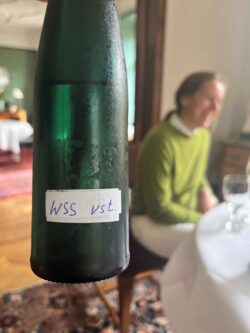 Lots 23-24: J.J. Prüm Wehlener Sonnenuhr Spätlese
Lots 23-24: J.J. Prüm Wehlener Sonnenuhr Spätlese
Apparently, as with the MFW boys, when I was in the Mosel and visiting Katharina Prüm, the auction Spätlese – the estate’s only entry for the auction this year – was not yet bottled. Still, for me this was one of my favorite auction bottlings and maybe one of my Spätlese of the vintage. The MFW boys didn’t like it as much as I did – but to me this is one of those special wines that really captures the essence of the vintage (extreme lightness, energy) while also having a certain very serious presence.
“This cask sample of the 2022er Wehlener Sonnenuhr Riesling Spätlese Auction offers a superbly aromatic and direct nose of almond, Conference pear, vineyard peach, spices, and minty herbs, all wrapped in delicate residues from its spontaneous fermentation. The wine proves initially comparatively broad and sweet on the smooth and delicate palate. The finish is more focused and proves very long and even more forceful. It’s still a work in progress, but all the elements are in place to produce a Spätlese of great smoothness and intensity within a decade or so.” 93-95 points MFW.
PRICING:
This will be a fascinating wine to watch this year. Last year, their auction Kabinett left jaws on the floor when it hammered at 405 Euros a bottle. The Spätlese followed at only 350 Euros; the Auslese after that at 300 Euros. The Prädikat on its head, as some nit-wit importer outfit in Brooklyn had been predicting. This year, with less heat on the 2022 vintage, Spätlese less and less in vogue (till we start our 2024 campaign, “Spätlese is the new Kabinett”) this might be a deal, at least for the savvy collectors.
Lots 33-36: Willi Schaefer Domprobst Kabinett #1 and Spätlese #13
I don’t really want to stoke this fire any more than I already have. Both of these wines are everything perfect (in their own way) about 2022.
“The 2022er Graacher Domprobst Riesling Kabinett is a fruity-styled wine made from fruit harvested on old vines in the Nikolauslay sector of the vineyard. It offers a stunning nose of cassis, blackberry, herbs, and spices. The wine is gorgeously well balanced and focused on the palate. A kick of tartness adds stunning raciness and elegance to the hugely intense finish. Despite the intensity, the wine remains incredibly Kabinett-styled in its structure and finesse. What a success!” 95 points MFW which is 100 for any other publication.
“The 2022er Graacher Domprobst Riesling Spätlese is a sweet wine made from fruit harvested in the prime Fergert sector of the vineyard. It offers a beautiful nose made of pear, pineapple, cassis, earthy spices, apricot, and herbs. The wine proves gorgeously playful with subtle exotic notes on
the palate and leaves a great feel of fresh herbs and whipped cream in the long finish. Zesty elements add a great racy side to the aftertaste. This is a truly stunning expression of Spätlese with an irresistible exotic side” 97 points MFW which is 119 for any other publication.
PRICING:
This will be another fascinating set of wines to watch this year. Last year, their auction Kabinett hammered at 155 Euros; the Spätlese went to 450 Euros a bottle! Hot damn. Willi Schaefer has arrived and, well, 1) they deserve it and 2) we told you so. Sitting with Christoph and Andrea Schaefer this summer, they seemed both thrilled and a touch sentimental. This is the paradox of this moment in German wine. We knew, we all knew, these wines were just outrageously undervalued. And now they are getting their rightful due, but this “rightful due” means the wines are now beyond the means of a lot of people who have loved and supported these wines for a long time. I suppose that’s life, and there are so many great estates that remain widely affordable, but there is always, I suppose, something to mourn in success.
Lots 42-47: Von Schubert – Maximin Grünhaus Kabinett Abtsberg #50 and 2021 Herrenberg Eiswein
Our communications got lost and I didn’t get a note from the estate about sending me the wines until I had left Germany: my loss apparently. I did not taste the wines but the MFW boys gave them high scores.
“The 2022er Maximin Grünhäuser Abtsberg Riesling Kabinett Nr. 50 was fermented down to fruity-styled levels of residual sugar. Slightly reductive at first (scents of bacon and smoke), this offers a beautifully aromatic and appealing nose of minty herbs, vineyard peach, candied grapefruit, anise, prune, cherry, and orange zest. The wine has the presence of a Spätlese on the palate as riper flavors of yellow peach, apricot, and guava kick in. The finish proves superbly long, even if a still sweet at the moment. Patience is needed for this beauty to develop all its complexity and precision.” 95+ points MFW which is 104 for any other publication.
“The 2021er Maximin Grünhäuser Herrenberg Riesling Eiswein was harvested on December 21, 2021, at -9°/-10°C (15.8°F/14°F). It offers a very pure and zesty nose of candied citrusy fruits, rhubarb, lime, acacia, candied apricot, quince, smoke, and honey. The wine is superbly intense and creamy on the palate, yet the zesty side makes for a very highly sprung and intense experience. The beautifully animating but firm acidic profile in the finish makes us opt to enjoy this beauty rather sooner than later.” 95 points MFW.
PRICING:
Von Schubert is getting big scores and the prices to match, though in the context of Egon and Prüm and Keller these are values. Last year the 2021 Kabinett hammered at 85 Euros; the 2021 Eiswein I’d guess will go for 500 Euros or so?
Lots 48-52: Lauer Kupp Kabinett #5, Kupp Spätlese #23, Feils Spätlese #24 and a 2011 Schonfels TBA
As I wrote last year, I’m obviously not a neutral party, but for me Florian Lauer’s Kabinett and Spätlesen are among the very, very best at the auction, period – not even taking price into account. Qualitatively for me they are unquestionably on the same quality level as Egon Müller in the Saar, and as Prüm and Willi Schaefer in the Mosel. And yet, year after year, they trade at somewhere between a 50-90% discount. Why? Honestly I have no idea. I guess because the history isn’t as deep at Lauer? They’ve only been in the VDP since 2012. Yes, people are talking and I am by no means the only one to notice the quality here, but still, the pricing remains absolutely bonkers-low.
For me, at this moment, Lauer and Adam are without question the STEALS of the VDP Prädikat auction. No one else is even close to the disparity between quality and price. The MFW boys didn’t like the wines as much as I did, but I have tasted the 2022 #5 Auction Kabinett three times and on two of these occasions I wrote the following: “One of the best Kabinetts I’ve ever had.” The Spätlesen too, are superb. It’s funny I asked Florian if he had any problem selling the Spätlese and he said: “No, not really. They taste dry here so it works fine.” This is funny as hell – it is also about as good a summary of the magic of the Saar valley as I’ve ever heard spoken.
“The 2022er Kupp Kabinett No. 5, as it is referred to on the central part of the label, was harvested on the original Kupp hill and was fermented down to fruity-styled levels of residual sugar (49 g/l). It offers a very elegant and smoky nose of bacon, wild herbs, mint, white flowers, spices, and anise. The wine proves superbly juicy on the palate, yet this combatively richness is well wrapped into intense zesty elements. The finish is electric and straight, and already dryish in style. This is a superb racy Kabinett.” 93 points MFW.
“The 2022er Kupp Spätlese No. 23, as it is referred to on the central part of the label, was harvested on the original Kupp hill and was fermented down to sweet levels of residual sugar (82 g/l). It offers a beautifully smoky and restrained nose of whipped almond cream, bergamot, anise, vineyard peach, a hint of toffee, and smoke. The wine is superbly playful and creamy on the delicately juicy and aromatic palate (yellow peach, tangerine, and almond cream). The creamy elements give way to finer ripe zesty and candied citrusy fruits. The finish is full of spices and shows great length with superb lightness.” 94 points MFW.
“The 2022er Feils Spätlese No. 24, as it is referred to on the front label, was made from clean fruit harvested at 84° Oechsle and was fermented down to sweet levels of residual sugar (84 g/l). It has a beautifully attractive and finely aromatic nose of ripe yellow fruits, tangerine, candied grapefruit, anise, earthy spices, and lavender. The wine proves juicy and comparatively broad and rich on the palate. Yet the finish has great energy and liveliness thanks to some beautiful candied citrusy elements, herbs, and spices. The fruity ripeness already clearly plays into Auslese category, but the finish is intense and straight.” 94 points MFW.
PRICING:
At this point, I’ve expected Lauer’s prices to rise dramatically for so many years that I’m now hopeful maybe they’ll just stay flat for a bit? That would be awesome, honestly? Last year the 2021 Kabinett #5 hammered at 40 Euro, the Kupp Spätlese #23 at 62 Euro and the Feils Spätlese #24 at 50 Euro. Let’s keep the prices here this year and gorge ourselves?
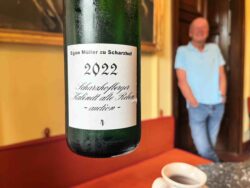 Lots 63-67: Egon Müller Scharzhofberg Kabinett “Alte Reben” and a 2015 Scharzhofberg BA
Lots 63-67: Egon Müller Scharzhofberg Kabinett “Alte Reben” and a 2015 Scharzhofberg BA
As I wrote last year, recommending Egon to a Riesling fan is like recommending a Porsche to someone who wants a fast car: it’s both very correct and very obvious. You do not need me to recommend Egon’s wines, though I’m going to anyway.
PRICING:
Last year the Kabinett went for 501 Euros a bottle; this year my best guess is it’ll be in the same general ballpark. The BA will trade at around 5,000 Euro a bottle?
Lots 73-75: Van Volxem Geisberg Kabinett Gold Capsule
I wasn’t able to taste this wine, and I’m sad about that. The Geisberg was apparently one of the great sites around the turn of the last century, commanding prices only beaten by the Scharzhofberg. This is Saar river history. Why this site was forgotten is something of a mystery, though an excellent piece by MFW outlines the history as well as the dramatic replanting of key parts of the vineyard by Van Volxem and Markus Molitor; click here to read about the Geisberg. I’m not 100% sure if this is the first vintage they are making wine here, but I do believe it’s the first wine from the site to go to the auction? The MFW boys liked the wine but it didn’t get crazy scores, see below.
“The 2022er Geisberg Riesling Kabinett, as it is referred to on the central part of the label, is a fruity-styled wine with offers a superbly attractive and finely aromatic nose of candied grapefruit, canned yellow peach, acacia, anise, and spearmint, with a whiff of volatile acidity in the background. The wine is juicy and aromatic on the structured and intense palate. The finish proves superbly long and has plenty of nice juicy fruits.” 91 points MFW.
PRICING:
I have no idea where this will go, as it has no track record, but given the fame of the site and the marketing swagger of Van Volxem, I bet it’ll get a healthy price – 80-120 Euro? Somewhere around there? 600 bottles, 60 magnums and one 6L going to auction.
I’ll be honest, we dipped our toes into this auction with some serious excitement. With the VDP auctions now getting more and more interest, we figured the periphery would be interesting. If there weren’t as many truly “wow” wines as we’d have hoped for, there are some fun things to consider for the value-hunter. Here are top seven picks, with an average opening-bid price of only around 19 Euros! Take out the 50-Euro Pinot Noir (far and away the most expensive wine on our list) and the average opening-bid drops to 16.25 Euros.
Lot 5: Bertram-Balthes 2020 Pinot Noir Treibgut “alte Reben”
I didn’t taste this wine, but I’ve always liked the style here. This is an Ahr valley estate with a more restrained presentation. Might be a fun wine if you wanna explore German Pinot Noir at the auction? The bottle starts at 50 Euro. I don’t have as much experience here with bidding and where the prices go, but there are only 120 bottles so maybe the wine will go up toward 100 Euro?
Lot 26: Loersch Trittenheimer Apotheke Kabinett
I didn’t taste these wines, but I’ve tasted a good amount of Loersch and this is a very serious estate working a great site. The MFW boys really liked these wines and gave them good scores. And here is, perhaps, where the *serious* deals may now reside. Consider that MFW gave the Kabinett 93 points and the estate will send 420 bottles to auction starting at 15 Euro! If the price doubles, we are still talking only 30 Euro. The Spätlese, below, got 95 points and will begin trading at 18 Euros? This could be fun.
“The Apotheke Riesling Kabinett 2022, as it is referred to on the central part of the label, was made from fruit picked at 83° Oechsle in the terraced part of the Vogelsang, a sector high up the hill, and was fermented down to fruity-styled levels of residual sugar (44 g/l). It proves still marked by residual scents from its spontaneous fermentation at first but quickly reveals very attractive and complex notes of vineyard peach, mint, thyme, rosemary, and fresh almond. The wine is superbly playful and structured on the palate and leaves a splendidly long and captivating feel of fresh orchard fruits. This is a superb Kabinett.” MFW 93.
Lot 28: Carl Loewen Thörnicher Ritsch Kabinett
I had to taste this wine, as outside of Hermann Ludes, only Loewen makes a Ritsch of any gravity. Curiously, the Ludes wine in 2022 from this parcel (the “Im Schneidersberg”) is dry-tasting at Ludes and bonkers-good. The Loewen Kabinett does not have the severity or cut of the Ludes wines – the styles of the two houses are very different – but this is a lovely wine. MFW 92 and 300 bottles start at 14 Euro!
“The 2022 Ritsch “Im Schneidersberg” Riesling Kabinett, as it is referred to on the front label, was made from fruit picked at 85° Oechsle in this particular Lieu-Dit tucked away in a side valley of the Mosel and was fermented down to fruity-styled levels of residual sugar (45 g/l). It has a fine smoky and herbal reduction at first, and develops a complex and attractive nose of spices, yellow peach, greengage, laurel, and anise. The wine is light-weighted and superbly playful on the palate. Juicy and fruity elements give way to zest and tension in the long and precise finish. This is a superb Kabinett in the making.” MFW 92.
Lot 32: Erben von Beulwitz Kaseler Nies’chen Kabinett “alte Reben” No. 7
I didn’t taste this wine, but this is another estate I’ve always respected. Not every wine is great, but outside of Von Schubert and Karthäuserhof, this is one of the few noteworthy estates in the tiny Ruwer valley. Also, to be crude: MFW 91 points and 600 bottles starting at 13.50 Euro.
“The 2022er Kaseler Nies’chen Riesling Kabinett Alte Reben No 7 was made from fruit picked at 92° Oechsle on 40-year-old vines and was fermented down to sweet levels of residual sugar (71 g/l). It offers a beautifully complex and herbal nose of anise, greengage, cassis, yellow peach, Conference pear, and almond cream. The wine proves delicately smooth and rich on the palate. The finish has a creamy delicacy and is enlivened by peach flavors. This wine clearly plays into Spätlese territory and, as such, a great creamy Riesling.” MFW 91.
Lot 38: Loersch Trittenheimer Apotheke Spätlese
As I stated above, I didn’t taste these wines, but I’ve tasted a good amount of Loersch and this is a very serious estate working a great site. The MFW boys really liked these wines and gave them good scores. And here is, perhaps, where the *serious* deals may now reside. The Spätlese got 95 points and will begin trading at 18 Euros? This could be fun.
“The Apotheke Riesling Spätlese 2022, as it is referred to on the central part of the label, was made from fruit picked at 88° Oechsle on un-grafted vines in the central part of the vineyard and was fermented down to sweet levels of residual sugar (75 g/l). It still shows light reduction at first but it quickly gives way to a very complex and captivating nose of smoke, earthy spices, vineyard peach, candied grapefruit, orange blossom, acacia, anise, and a hint of toffee. The wine has great presence and finesse on the palate, which shows a gorgeous energetic side. There is some richness, but it is already very well integrated into the wine. The finish is full of zest and fine spices and proves mouthwatering. This is a splendid Spätlese, with both complexity and zesty lift.” MFW 95.
Lot 39: Kerpen Wehlener Sonnenuhr Spätlese
Kerpen is another old-school estate I’ve really enjoyed over the last few years. This bottle needs some time, but again, to be crude: 91+ MFW and 300 bottles will go to auction at 12 Euro.
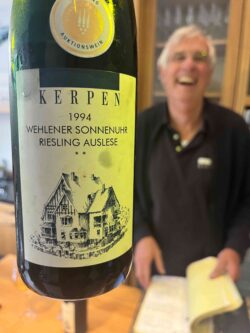
“The 2022er Wehlener Sonnenuhr Riesling Spätlese * was made from fruit picked at 93° Oechsle and was fermented down to fully sweet levels of residual sugar (80 g/l). It is still marked by a strong sulfur reduction at this stage and needs extensive airing before offering scents of canned yellow peach, Conference pear, almond cream, bergamot, candied grapefruit, and jasmine. The wine proves
particularly attractive on the palate, where plenty of creamy and juicy fruits make for a smooth and suave side. The finish is smoky, zesty, and superbly long. This Spätlese will need extensive cellaring, but there is great potential, so patience is needed for this little beauty to fully develop its complexity and reach its peak.” MFW 91+.
Lot 50: 1994 Kerpen Wehlener Sonnenuhr Auslese**
Like I said, Kerpen is another old-school estate I’ve really enjoyed over the last few years. Just a stunning, mature, and ready-to-drink Auslese perfectly stored at the estate for nearly 30 years: 93 MFW and 240 bottles will go to auction starting at 25 Euro.
“The 1994er Wehlener Sonnenuhr Riesling Auslese ** was made from only slightly botrytized fruit picked at 93° Oechsle and was fermented down to sweet levels of residual sugar (67 g/l). This nicely deep golden-colored wine exhibits a superbly mature nose of wood fire, incense, anise, laurel, acacia honey, orange marmalade, licorice, and wet slate smoke. The wine proves comparatively light-weighted and superbly zest on the palate, where some tertiary including notes of nutmeg, orange zest marmalade and toffee come through. The finish is already dryish in style, so this is now at full peak. The aftertaste is full of lime and spices. This mature drinking Auslese is superb.” MFW 93.
Lot 4: 2008 Schlossgut Diel Goldloch Brut Nature 1.5L
I remember being at a wine fair years ago; I saw Caroline and her husband Sylvain across the room and we smiled, so I ran over just to give them both hugs. I only had a minute, but they poured me a single-vintage sparkling wine – I don’t remember the wine or the vintage. But I do remember being blown away – it was superb. All this to say this estate has a history making sparkling wines and the best are among the best in Germany. Only 85 mags come out of the estate’s cellar for this auction – don’t miss.
“This special auction batch of the Goldloch 2008 Riesling Brut Nature, as it is referred to (and partially handwritten) on the front label, was fermented and aged in Stückfass for 10 months before being bottled in magnums and aged for 163 months (i.e. more than 13.5 years) on its lees and then disgorged without dosage in March 2023 (the disgorgement date is written on the back label). The nose is gorgeous and magnificently complex, with notes of almond, minty herbs, spearmint, vineyard peach, smoky herbs, thyme, and may tree. It is beautifully playful on the delicately spicy and zesty palate, which superbly plays with fine and light creamy elements. The finish has some pastry and bakery flavors, as well as fine notes of mature nut and almond cream. The after-taste leaves a very fresh and vibrating lime-driven feel. This is a splendid mature, yet fresh and precise Sekt.” MFW 94
PRICING:
As with everywhere, sparkling is in vogue and I’d expect this to command a pretty serious price. Do we break 200 Euros? Yeah, and maybe a good deal more? Let’s see.
Lots 6-7: Wittmann “La Borne”
I visited Philip Wittmann for the first time in many years this summer and I have to admit to being really, really impressed with the entire collection. So impressed I reached out to their importer to try and buy some – if you can find some 2022ers, you should consider. It is among the lightest and most direct collections I’ve ever tasted from the estate. The “La Borne” bottling, from the Morstein vineyard, is an auction mainstay.
“The 2022er ‘La Borne’ Riesling Alte Reben, as it is referred to on the consumer label, comes from a parcel planted with 45-year-old vines in the Grand Cru Westhofener Morstein and was fermented and aged in Halbstückfass (600-liter wooden cask). This cask sample offers a superbly complex and attractive nose of minty herbs, smoke, candied lemon, pineapple, William’s pear, greengage, and pineapple, with a hint of fine honey in the background. The wine is superbly well structured on the juicy and finely fruity palate. It gains intensity and focus as spicy and zesty elements come through. The finish is very long and more refined. ” MFW 93-95
PRICING:
You’ll pay for the quality, alas. This wine hammered at 390 Euros last year and I’d expect it in the same general ballpark.
Lots 13-14: Schäfer-Fröhlich “Final”
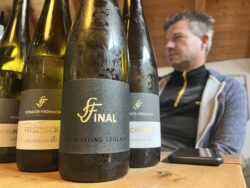 Oh good lord. I don’t understand Tim Fröhlich and how every year is the best year. But somehow it is? This is a profound, *profound* GG sourced from the oldest and steepest parcel of the Felseneck. I’m too old to know how to insert a “mind-exploding” emoji, but if I knew how, I would do it here.
Oh good lord. I don’t understand Tim Fröhlich and how every year is the best year. But somehow it is? This is a profound, *profound* GG sourced from the oldest and steepest parcel of the Felseneck. I’m too old to know how to insert a “mind-exploding” emoji, but if I knew how, I would do it here.
“The 2022er Riesling Trocken ‘Final,’ as it is referred to on the front part of the label, comes from fruit harvested in one of the oldest and steepest part of the Bockenauer Felseneck and saw extensive aging (until August after the vintage, together with the GGs). This cask sample initially presents a hugely primary, herbal, and smoky nose of bacon, yuzu, thyme, and spices. With a little more airing, it turns out to be delicately floral and driven by fine herbal tea, lime tree, dill, rosemary, and tangerine. The wine is comparatively light-weighted and straightforward on the dynamic and herbal palate. However, it shows more depth and presence as it unfolds. The finish is bone-dry and full of spices, with a hint of tartness still in need of integration. This is an impressive, focused dry Riesling.” MFW 95-97
PRICING:
Ug. You’ll pay for the quality here too, alas. This wine hammered at 500 Euros last year and mags at 1550 Euro. I’d expect it in the same general ballpark again this year.
Lots 15-18: Emrich-Schönleber Auf der Ley GG and 2004 Halenberg Eiswein
I have the same comment for Frank Schönleber that I had for Tim, above: I don’t understand how every year is the best year. But somehow it is? What I like about both wines is, again, the absolute delicacy of the vintage: 2021 was a hammer, 2022 is an arrow. This is a superb bottle and – at least in the company of the best, best, best – it remains something of a deal – see pricing note below.
“The 2022er Auf der Ley Riesling GG, as it is referred to on the front part of the label, comes from the prime “Lieu-Dit” (Gewann) Auf der Ley situated just above the Monzinger Halenberg, and within the Grosse Lage Monzinger Frühlingsplätzchen. This cask sample offers a superbly attractive and nicely complex nose of almond cream, jasmine, canned yellow peach, orange blossom, lime tree, and acacia. The wine is comparatively light-weighted and delicately creamy palate with fine juicy and light flavors driven by almond and peach. The finish is refined and delicately smooth with a touch of candied citrusy fruits and herbal elements adding a playful side. This dry Riesling, with its fine, light texture, is excellent.” MFW 91-94
“The 2004er Monzinger Halenberg Riesling Eiswein (with a golden capsule) has a beautiful golden-orange color offers an absolutely gorgeous and fully mature nose of candied citrusy fruits, orange peel, acacia honey, passion fruit, cinnamon, nutmeg, quince jelly, and white truffle. The wine shows enormous concentration and purity on the aromatic and dynamic palate. There is plenty of intensity and energy on the mature yet still fresh and vibrating palate. What a splendid expression of mature Eiswein!” MFW 98
PRICING:
So, yes, magnums of this bottle only a few years ago auctioned at under 300 Euro. Last year regular 750mls went for 243 Euro, mags for 550. This is no small sum of money, to be sure, but compared to Wittmann and Schäfer-Fröhlich, we are talking about a significant discount. Why, you might ask, is there such a differential? Is it the quality? Absolutely not. All the estates have different styles, you may certainly prefer one to the other. The biggest difference here is the quantity of wine sent to the auction: Both Wittmann and Schäfer-Fröhlich send only 300 bottles of their top dry Rieslings to the auction. Emrich-Schönleber is sending 700 bottles and 120 magnums – and 12 three-liters! These quantities will keep the prices a bit lower for us all. This is a good thing. Send Frank Schönleber a nice “thank you” card, ok? As for the price on the Eiswein, impossible to know. Only three bottles are going to auction so… expensive?
Lots 28-29: Joh. Bapt. Schäfer Goldloch Kabinett
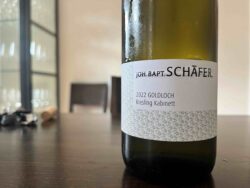 Auction insiders here know this is a bottle Klaus Peter Keller turned me onto a few years ago; I have been buying it ever since and it used to be a song. It’s a more expensive song these days, but still a great value. The style here is restrained, sharp and mineral-driven. Drink it up.
Auction insiders here know this is a bottle Klaus Peter Keller turned me onto a few years ago; I have been buying it ever since and it used to be a song. It’s a more expensive song these days, but still a great value. The style here is restrained, sharp and mineral-driven. Drink it up.
“The 2022er Goldloch Riesling Kabinett, as it is referred to on the central part of the label, was made from a pre-selection of fruit picked early at 84° Oechsle on the same 50-year-old vines as those used for the GG, and was fermented with ambient yeasts down to fruity-styled levels of residual sugar (53 g/l). It offers a beautifully primary and smoky nose of bacon, green herbs, anise, white peach, and dried white flowers. The wine proves quite juicy and finely sweet on the aromatic and ripe palate (which has some Spätlese presence), yet the finish is superbly focused and playful. There is energy and tension in the spicy finish. This is a superb fruity-styled Riesling.” MFW 93
PRICING:
This used to trade in the 20s or early 30s – last year it hammered for 45 Euros. Still a deal. I’d expect it to hang in this general price-range.
Lot 30: Charity Dinner for six people with the Kellers and the Diels!
Do you have a special anniversary coming up? Maybe pass on that trip to the Seychelles and spend your money more intelligently: Blow the entire budget on a dinner with the Kellers and the Diels with rare treats from the cellar! Keller will provide a three-vintage vertical of G-Max and a “surprise GG” not shown yet… The Diels will provide three vintages of their top sparkling wines and a “Pinot Noir surprise” – and every cent raised will go to a charity that helps to build communities through planting trees. And while I’m sure the wines will be great, you know what’s even better? Julia Keller and Sylvain Diel will be personally cooking for you! This is truly a meal you’ll never forget – a “priceless” experience, as they say. If you bid through me and win, I am offering to you, at no additional cost, my company at this dinner!
PRICING:
Around the price of a trip to the Seychelles?
Lots 31-32: Keller Hipping Kabinett
360 bottles of Hipping Kabinett go to auction, with bids starting at 60 Euro. Is this your chance to grab a Keller auction Kabinett “on the cheap?” Hmmm… that depends on your definition of cheap. However, there is some chance that the fancy-pants collectors will pass or go lighter on 2022, giving us mortals a chance at a more-reasonable-ish price? Let’s pray. The auction will be on Sunday, so that’s appropriate I guess for some of us, if you observe. I don’t, but I may start? Twelve magnums go to auction too, and they will be more than twice as expensive as the 750mls, rest assured.
Lots 33-34: The GG “Grossen Lagen Auction Case”
This is unquestionably the most exciting lot going to auction this year – and I mean from all of the three German auctions covered here. Good lord, my hands get all sweaty even writing about these two lots.
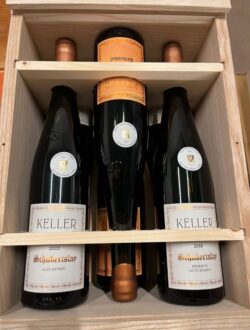 “The 2022 Schubertslay -Alte Reben-, as it is referred to on the front label, was made from fruit harvested on 120-year-old un-grafted vines. It offers a captivating and gorgeously layered nose of almond cream, yellow flowers, smoke, anise, bergamot, vineyard peach, orange blossom, thyme, and grapefruit. The wine is superbly playful on the very delicate and subtly flower-infused palate. There is a fine touch of creamy elements giving way to more playful candied citrusy fruits. The finish has huge energy, depth, and shows gorgeously smoky flavors. This is a stunning dry Riesling in the making!” MFW 97
“The 2022 Schubertslay -Alte Reben-, as it is referred to on the front label, was made from fruit harvested on 120-year-old un-grafted vines. It offers a captivating and gorgeously layered nose of almond cream, yellow flowers, smoke, anise, bergamot, vineyard peach, orange blossom, thyme, and grapefruit. The wine is superbly playful on the very delicate and subtly flower-infused palate. There is a fine touch of creamy elements giving way to more playful candied citrusy fruits. The finish has huge energy, depth, and shows gorgeously smoky flavors. This is a stunning dry Riesling in the making!” MFW 97
“The 2021 Pettenthal, as it is simply referred to on the front label, is a bone-dry wine made from very low yields and pressed over 3 days with an over 100-year-old basket press. It offers a slightly reserved yet very complex and superbly attractive nose of lime tree, candied citrusy fruits, orange blossom, may tree, rose, and a hint of vineyard peach and Conference pear. The wine is delicately juicy and refined on the comparatively lightweight and refined palate. The finish has more energy and grip with plenty of spicy and zesty elements coming through. The after-taste is bonedry and layered. This refined dry Riesling is superb and full of finesse.” MFW 95
“The 2018er Schubertslay Réserve -Alte Reben-, as it is referred to on the front label, is a barely off-dry wine made from fruit harvested on 120-yearold un-grafted vines which was fermented and aged in small barrels before being bottled and kept in the Estate’s cellar for five years. It offers an absolutely captivating and multi-layered nose of smoke, almond cream, lime tree, lavender, orange blossom, may tree, Conference pear, and juniper. The wine is superbly delicate yet very pure and animating on the palate. It combines a hint of richness with magnificent and energetic notes of candied citrusy fruits and fine smoke. The finish is still tight and already dry in taste, and already hints at the greatness to come. Patience is needed. This is an absolutely magnificent Riesling!” MFW 98
PRICING:
I’m honestly not sure where these will land. Bidding on Keller is a bit like playing poker. I’m not ready to give my hand away yet, but email us and we can talk.
Any questions or comments? Email us orders@vomboden.com